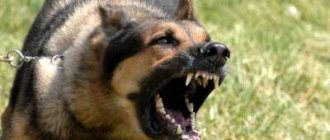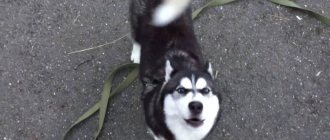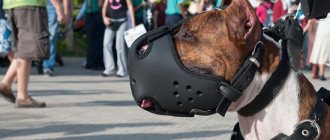A dog leash is one of the most important accessories, without which it is not recommended to take your pet outside. And we are not just talking about legal requirements. If the dog is on a leash, the owner can be calm about his safety. It is important to know how to train a puppy to use a leash. If you do not start training in a timely manner or do it incorrectly, then as your dog ages, it will be more difficult to handle. The problem is especially acute for large breeds such as Rottweiler, Doberman, Labrador or American Amstaff Terrier.
Why does a dog need a leash?
As soon as a puppy appears in the house, the owner needs to think about purchasing equipment for walking. A leash will not only save the owner from a possible fine, but will also reduce the risk that the pet will run away, get hit by a car, or start a fight with other dogs. Using a long strap, you can provide your pet with maximum freedom to play, while at the same time, if necessary, maintaining the ability to limit his movement.
A leash keeps your dog safe
There is a certain procedure that helps to effectively train an animal of any age and temperament type. During the training process, it is very important to adhere to the correct sequence of steps, not starting the next stage of training until a positive result has been achieved in the previous step.
A leash allows you to limit your pet's movement in times of danger.
At what age should a puppy be taught to use a leash?
The owner must fasten the leash to the collar from the very first time he goes outside, and before that, accustom the dog to it at home. It seems that at the age of a puppy he is not yet capable of scaring passers-by or harming them. However, he may become scared of himself, such as a car horn or another large dog. In a state of fright, he can break away and run away. The result will be either the loss of the pet or a collision with a car.
During the first walks, you need to let the puppy choose the route to follow and just follow him. The walk time should be at least 20 minutes, and preferably 40. After accustoming the puppy to the existence of a leash, you need to proceed to the next stage of training. It is needed so that the dog can calmly walk next to the owner and not be pulled by the leash.
NOTE! Experts advise choosing one of two available types of training.
When choosing, you need to pay attention to the character and age of the dog:
- Loyal
The method is to stop the owner every time the dog pulls on the leash. After some time, usually several days, the dog must understand that when the leash is pulled, nothing happens and it cannot go faster, but on the contrary, it stops altogether. With this method of training, the owner must show restraint and patience.
- Jerk method
This type of training can be used for puppies that have reached the age of 4.5-5 months. For training you will need a strong leash and a parfos (strict collar). With this type of training, the dog can be released 2.5-3 meters away from you, but when the leash is pulled, the owner jerks the pet towards him at the usual distance.
The duration of leash training for a puppy is approximately 6-7 days. During this time, almost all dogs understand the uselessness of their body movements and do not want to experience the unpleasant sensations of the owner’s jerks.
REFERENCE! When purchasing parfos, you need to choose the right shape of the teeth. They should be smooth and with rounded ends. Using this form, you can keep your puppy under control without leaving scratches or other damage on his delicate neck.
For what reasons may a dog not like a leash?
How to train a puppy to wear a diaper at 1, 2 or 3 months
Most often, owners are faced with pets’ rejection of the leash. The first feelings of discomfort remain in the dog’s memory for a long time. This greatly interferes with the learning process.
A dog may not like a leash for the following reasons:
- He experiences pain because the collar is not fitted correctly.
- Previously, the owner allowed him to play with the ammunition. After this, most often the dogs refuse to walk with her. There is only one way out in such a situation - purchasing a new collar.
- The pet was beaten with a leash.
Veterinarians recommend using a special vest-harness that will not hinder movement. But such ammunition is not suitable for training.
The dog doesn't like the leash
Selection of ammunition
How to toilet train a puppy in an apartment quickly
There are several types of ammunition that need to be selected depending on the characteristics of the pet, its height and physique.
Roulette
This type of leash is convenient for walking, as the animal has freedom of movement. He will be able to run away to the required distance, but the leash will not fall to the ground and get dirty, it will always be under tension. If necessary, the owner can fix the desired length of the leash. The tape measure is best chosen for small breeds, such as Spitz or Chihuahua.
Roulette leash for small breed dogs
Driver leashes
The main advantage of a walker leash is the maneuverability of controlling your pet. But there is one drawback to this type of ammunition. The free end must be wound around the brush. If the dog is large, then the chain-driver can injure the owner with a sharp jerk.
Ringovka
Full control over your pet can be ensured with the help of a ring. This type speeds up the training process, but it is not recommended to use it at home, as it will be based on the dog’s negative experience. Rinovka is not used for small breed dogs.
Getting to know the ammunition
The collar and leash must be prepared in advance. It is better to opt for a light collar made of soft materials and a short leash (no more than 1.5 m). For some breeds that are not large in size, a harness is preferable. A self-retracting leash in the form of a tape measure and a silk cord are not suitable for puppies. Before trying on the ammunition, keep it in the apartment for some time: it is necessary for the foreign odors to dissipate. You can put the fur that has been combed from your pet next to it, so that the equipment seems more familiar to the puppy.
It is important not to scare your pet when introducing new objects. Let your puppy sniff the equipment so it doesn't scare him. You need to get used to the collar gradually. First, you need to teach the puppy to stick his head into the accessory on his own, motivating him with a treat. After the pet sticks its head into the collar, it must be distracted so that it does not immediately try to remove it, but remains in the collar for some time. If the puppy is worried and tries to get rid of the collar, do not insist - take it off. Gradually the baby will get used to it, and the time he spends in the collar will increase. To quickly accustom him to this important accessory, you can put a collar on your puppy when he sleeps. You can use a leash only after your pet has already become accustomed to the collar. The leash must be attached to the collar, and its end must be left free. Don't let your dog play with the leash or chew it.
How to accustom a puppy to a collar: basic rules
Leash training should begin at an early age, as older dogs find it more difficult to get used to an uncomfortable thing. Sometimes you have to teach a dog to walk on a leash that has been in an enclosure for a long time. This is a difficult training process, since the dog can react unpredictably, he will chew, get angry, growl, and show aggression. In such situations, it is useful to take your dog with a long leash, at least five meters.
Important! It is best to start training your pet in a deserted place.
The adaptation process should be as comfortable as possible. It is necessary to give the dog the opportunity to get comfortable and move freely, so it is recommended to lower the harness to create the illusion of free movement.
Once you manage to tame the dog and it gets used to the presence of a leash, you can gradually reduce the distance. The duration of training for an adult dog should not be more than 30 minutes. Veterinarians recommend determining it individually so as not to create a negative reaction in your pet.
Start date
When studying the rules of how to teach a dog to a leash, you need to be prepared for the fact that the puppy will not accept the equipment with joy. He will scratch, spin, try to rip off the collar, and resist. To reduce stress, you must first introduce the puppy to a new thing, let him smell it, and study it carefully.
As soon as the collar is put on your pet for the first time, you need to captivate him with something interesting, play with him, and give him a tasty treat. In the first days, you should not leave the dog in the collar all day. Ten minutes is enough to get acquainted.
Important! You cannot remove the collar yourself if your pet tries to do so. Thus, the owner will show weakness. In such a situation, you need to wait until the puppy switches to something else.
You need to put the collar on two to three times a day for 10 minutes. As soon as the pet stops being afraid and tugging at the equipment, you can gradually increase the time.
Leash training is recommended to start at an early age.
Frequent walks
When the puppy turns three months old, you can start thinking about how to teach your dog to walk on a leash. In the first weeks, it is recommended to take your pet out at least five times a day. Each walk should be 20 minutes long. Then, every four weeks, the duration of the walk is gradually increased.
During a walk, you need to pay attention so that the leash does not tighten. If the puppy goes to a dangerous place, it is recommended not to drag it, but to pick it up and carry it.
Principles of training a puppy
The puppy can get used to the new equipment in a few days, provided that it does not cause any discomfort to the baby. In order for the dog to get used to it faster, owners need to learn the rules for teaching a puppy to use walking accessories:
- training should be gradual: first let the dog get used to the collar, then fasten the leash;
- As soon as you put the product on your pet, praise him or treat him with a treat;
- do not hit the dog with walking items and do not let it play with them: the dog must be neutral towards the equipment;
- first put on accessories for 15–20 minutes, then gradually increase the time to several hours;
- before you start teaching your puppy to walk on a leash, let him burn off excess energy - play or run with your pet;
- The first exercises are best done at home, and when the dog gets used to it, you can go for full walks;
- If during training the puppy starts to run in the wrong direction, take the baby in your arms or distract him with a toy, but do not pull or jerk him.
If you follow these recommendations, your pet will quickly get used to new things, however, teaching him to walk on a leash next to his owner will take more time: from one week to a month.
The role of tasty rewards
The pet owner needs to be prepared for the fact that the training process will require a lot of patience. It is important that the puppy’s training is based not on aggression, but on affectionate treatment. Veterinarians recommend preparing a favorite treat for your pet, which will be used as a reward. It is best if it is food that is not available to the dog at home.
Important! You can give a treat only when the puppy has fulfilled the command perfectly. You can't reward him for just being tired. In this situation, it is better to distract him with his favorite toy.
How to teach an adult dog to walk on a leash
The main rule in training and getting used to a collar is consistency. It is important to be patient and not expect too quick results. There are several ways to learn how to train your pet.
Loyal way
This is the most loyal method that will help maintain the puppy’s trust in its owner. But you need to be prepared for the fact that it will take a long time and patience. Training is based on the following actions:
- The owner must call the puppy by name and attach a collar and leash to it. It is important at this moment to pet and speak affectionately to the pet in order to build trust.
- While walking, when pulling on the leash, you need to stop. In this way, the puppy will understand that the owner’s behavior depends on its movement.
- The owner must let the pet feel that moving slowly nearby will be more effective than running quickly and constantly stopping.
- Every time you stop due to tension, you need to give your dog a treat.
Gradually, during the learning process, goodies are exchanged for praise.
The hard way
This method is most suitable for adult dogs. It is used for animals aged four months and older. As soon as the dog starts to run to the side, he is jerked sharply. It is important to act in such a way as not to cause pain.
Hard way of training
Duration of exercises
A dog, like a child, cannot concentrate on one activity for a long time. Therefore, the number of repetitions of the same exercises during one day should not be large, otherwise the dog will get tired and develop a negative attitude towards them. Therefore, you have to take it not by the duration of classes, but by calendar time and a fairly long rest. Be patient and understand that you won’t be able to teach, much less retrain, a dog in one week.
In this way, you will not only teach your dog to walk on a leash, developing a calm and conscious attitude towards it, but also create a strong bond between you, thanks to which the dog will feel your protective attitude, protection and self-confidence.
What not to do
There are a number of mistakes that owners make when training their pet to use a leash. These include:
- tightening the collar too much, this causes pain and discomfort to the pet;
- rudeness and aggression during the donning process;
- sudden jerks during a walk, the animal will associate the collar with constant pain;
- games with a leash.
The owner must convince the dog that a collar and leash are the main attributes for a walk!
How to choose a leash and collar for a dog?
Equally important in training a puppy to use a collar and leash is the correct choice of these accessories. After all, if the collar is too heavy and rubs the skin, then the dog will avoid it. It is best to choose an accessory made of soft material:
- nylon;
- skin;
- tarpaulin
You should not purchase a wide collar for a puppy - this type is intended for chain dogs or adult representatives of large breeds. It should be about one and a half to two centimeters wide. It is very convenient if the buckle and ring for attaching the leash are nearby - then you don’t have to turn the collar once again after putting it on.
It is better for inexperienced dog breeders to avoid a jerk collar (choke, parfors), since without proper practice it can negatively affect the puppy’s upbringing. You should also refuse the tempting purchase of an accessory decorated with rhinestones, rivets, and spikes - they are impractical, expensive, and sometimes even dangerous.
The choice of leash is simple - you will need one short one for walking (about 2m), and a second long one for training (8-10m). Like a collar, a leash can be made from leather, nylon or canvas. The second two are cheaper and more practical at first. Before directly purchasing a leash or collar, we would advise you to look at the assortment, read the characteristics and prices in online stores, and then ask clarifying questions from a consultant based on the sorted models and buy an excellent product. To make choosing easier, here are a couple more tips. You need to pay attention to the quality of the stitching and whether the leash at the ring is stitched. It is better not to buy a roulette leash to train a puppy, as the dog’s obedience may suffer significantly.
Useful tips
In order for the learning process to bring maximum results, it is important that the rules are followed not only by the pet, but also by the owner.
Dog handlers recommend that novice dog breeders follow these rules:
- For training, choose only places familiar to the dog.
- If training takes place at home, it is important that no one distracts your pet.
- You cannot begin the next stage of training if the puppy has not yet mastered the previous one.
- Hyperactive pets need to be dealt with after long walks.
Following simple rules will help you quickly and stress-free accustom your pet to a leash. Affection and attention will give a 100% reliable result.











